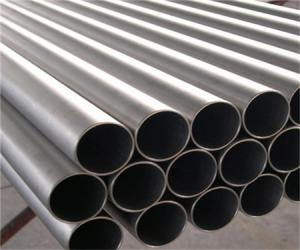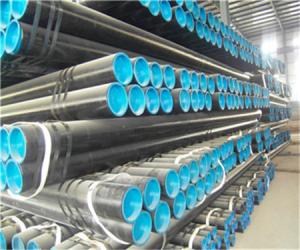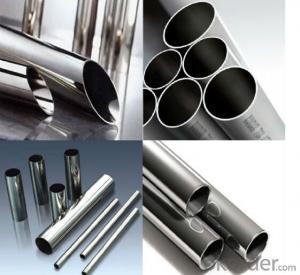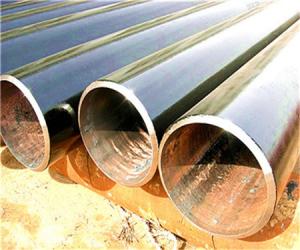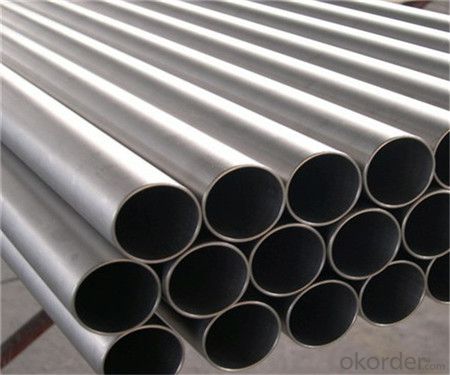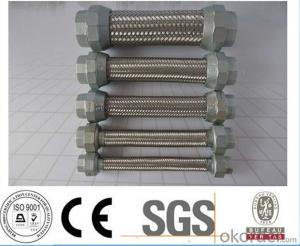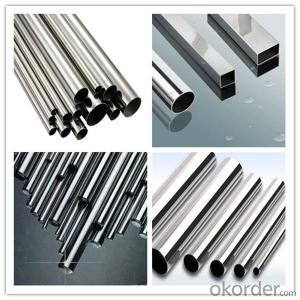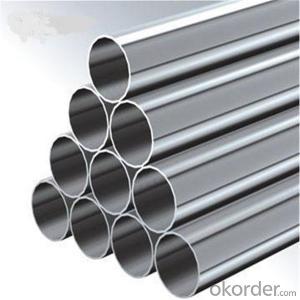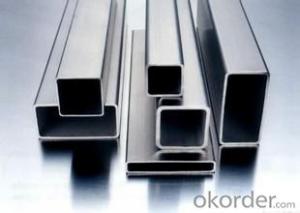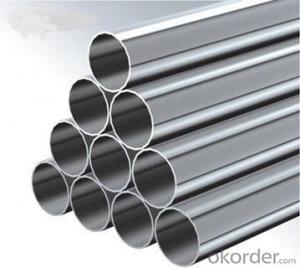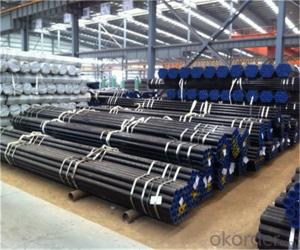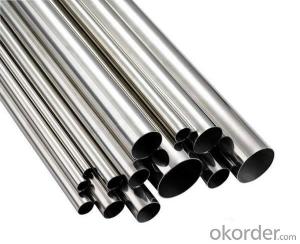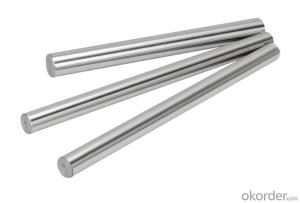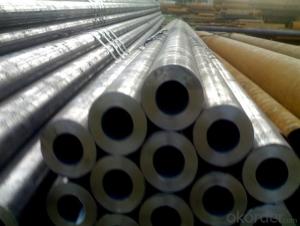Welded 304 Stainless Steel Pipes Manufacturer
- Loading Port:
- China Main Port
- Payment Terms:
- TT or LC
- Min Order Qty:
- 30 kg
- Supply Capability:
- 12000 kg/month
OKorder Service Pledge
OKorder Financial Service
You Might Also Like
Specifications
1、Structure of Seamless Pipe ASTM A106/53 Description:
Seamless pipe is formed by drawing a solid billet over a piercing rod to create the hollow shell. As the manufacturing process does not include any welding, seamless pipes are perceived to be stronger and more reliable. Historically seamless pipe was regarded as withstanding pressure better than other types, and was often more easily available than welded pipe.
2、Main Features of the Seamless Pipe ASTM A106/53:
• High manufacturing accuracy
• High strength
• Small inertia resistance
• Strong heat dissipation ability
• Good visual effect
• Reasonable price
3、Seamless Pipe ASTM A106/53 Specification:
Standard | GB, DIN, ASTM ASTM A106-2006, ASTM A53-2007 |
Grade | 10#-45#, 16Mn 10#, 20#, 45#, 16Mn |
Thickness | 8 - 33 mm |
Section Shape | Round |
Outer Diameter | 133 - 219 mm |
Place of Origin | Shandong, China (Mainland) |
Secondary Or Not | Non-secondary |
Application | Hydraulic Pipe |
Technique | Cold Drawn |
Certification | API |
Surface Treatment | factory state or painted black |
Special Pipe | API Pipe |
Alloy Or Not | Non-alloy |
Length | 5-12M |
Outer Diameter | 21.3-610mm |
Grade | 20#, 45#, Q345, API J55, API K55, API L80, API N80, API P110, A53B |
Standard | ASME, ASTM |
1) Material:20#(ASTM A 106/A53 GRB.API5LGRB,GB),45#,16Mn,10#.
2) Specification range:OD:21.3-610mm,WT:6-70mm,length:6-12m or according to the requirement of clients.
3) Excutive standards:GB,ASME API5L.ASTM A 106/A53,Despite of the above standards,we can also supply seamless steel pipe with standard of DIN,JIS,and so on,and also develop new products according to the requirements of our clients!
4) Surface:black lacquered,varnish coating or galvanized.
5) Ends:Beveled or square cut,plastic capped,painted.
6) Packing:bundles wrapped with strong steel strip,seaworthy packing.
4、Packaging & Delivery
Packaging Details: | seaworthy package,bundles wrapped with strong steel strip |
Delivery Detail: | 15-30days after received 30%TT |
5、FAQ of Seamless Pipe ASTM A106/53:
①How is the quality of your products?
Our products are manufactured strictly according to national and internaional standard, and we take a test
on every pipe before delivered out. If you want see our quality certifications and all kinds of testing report, please just ask us for it.
Guaranteed: If products’ quality don’t accord to discription as we give or the promise before you place order, we promise 100% refund.
②How about price?
Yes, we are factory and be able to give you lowest price below market one, and we have a policy that “ for saving time and absolutely honest business attitude, we quote as lowest as possible for any customer, and discount can be given according to quantity”,if you like bargain and factory price is not low enough as you think, just don’t waste your time.Please trust the quotation we would give you, it is professional one.
③Why should you chose us?
Chose happens because of quality, then price, We can give you both.Additionally, we can also offer professional products inquiry, products knowledge train(for agents), smooth goods delivery, exellent customer solution proposals.Our service formula: good quality+good price+good service=customer’s trust
SGS test is available, customer inspection before shipping is welcome, third party inspection is no problem.
6、Seamless Pipe ASTM A106/53 Images:
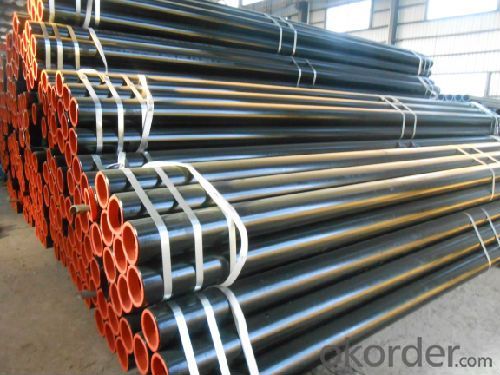
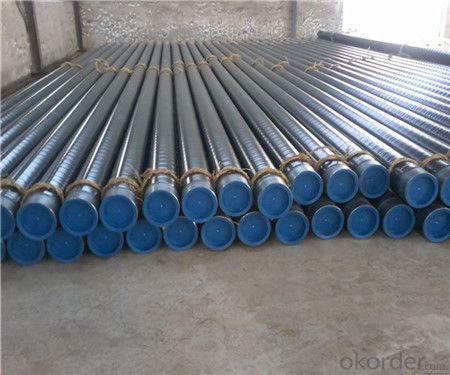
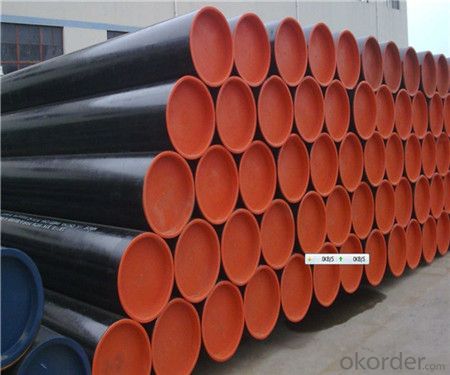
- Q: Can stainless steel pipes be used for steam piping?
- Indeed, steam piping can utilize stainless steel pipes. Renowned for its exceptional resistance to corrosion, stainless steel proves to be a superb option for steam-related purposes. In order to endure elevated temperatures and pressure, steam piping necessitates materials capable of withstanding such conditions, a criterion that stainless steel effortlessly meets. Furthermore, stainless steel pipes boast commendable thermal conductivity, ensuring the efficient transfer of heat within steam systems. Nevertheless, it is crucial to carefully deliberate the specific grade of stainless steel and its compatibility with steam applications, as certain grades may prove more suitable than others based on the system's conditions and requirements.
- Q: Can stainless steel pipes be used for cryogenic applications?
- Yes, stainless steel pipes can be used for cryogenic applications. Stainless steel has excellent low temperature properties, such as good mechanical strength and resistance to embrittlement, making it suitable for handling cryogenic fluids and gases at extremely low temperatures.
- Q: Can stainless steel pipes be used for refrigeration systems?
- Indeed, refrigeration systems can utilize stainless steel pipes. Stainless steel, being an exceedingly robust material, exhibits exceptional resistance against corrosion, rendering it perfectly suitable for deployment in refrigeration systems where both moisture and low temperatures are prevalent. Moreover, stainless steel pipes boast remarkable thermal conductivity, facilitating efficient and effective heat transfer throughout the entire system. Furthermore, stainless steel pipes are effortlessly cleanable and maintainable, while also demonstrating the capacity to withstand significant pressure, thereby making them highly appropriate for deployment in refrigeration systems necessitating unwavering and enduring performance.
- Q: What are the advantages of using stainless steel pipes in the oil and gas industry?
- Using stainless steel pipes in the oil and gas industry offers several advantages. Firstly, their corrosion resistance makes them ideal for transporting oil and gas, as they can withstand extreme temperatures, harsh chemicals, and corrosive environments without the need for costly repairs or replacements. Secondly, stainless steel pipes have high tensile strength, allowing them to handle heavy loads and high-pressure environments, making them suitable for long-distance transportation. Additionally, their non-porous and smooth surface prevents bacterial growth and contamination, ensuring the purity and quality of the transported fluids. Furthermore, stainless steel pipes can withstand high temperatures without deformation or degradation, making them suitable for the extraction, refining, and transportation processes. Their flexibility allows for easy customization and installation, reducing the need for additional connectors or fittings. Moreover, stainless steel pipes have a long lifespan and require minimal maintenance, reducing downtime and costs in the industry. Lastly, stainless steel is highly recyclable, making it an environmentally friendly choice. In conclusion, the numerous advantages of using stainless steel pipes make them a reliable and efficient option for transporting oil and gas, ensuring the safety and integrity of the operations.
- Q: What is the difference between 304F and 316F stainless steel pipes?
- The composition and characteristics of 304F and 316F stainless steel pipes are what set them apart. 304F stainless steel is categorized as an austenitic stainless steel, meaning it contains high levels of chromium and nickel. It is renowned for its exceptional corrosion resistance, weldability, and formability. Consequently, it is widely used in various industries, including food processing, chemical processing, and construction. However, 304F stainless steel is not as resistant to chloride corrosion as 316F stainless steel. On the flip side, 316F stainless steel is also classified as an austenitic stainless steel, but it has elevated levels of chromium, nickel, and molybdenum compared to 304F stainless steel. The addition of molybdenum enhances its corrosion resistance, particularly against chlorides and other aggressive chemicals. As a result, 316F stainless steel pipes are suitable for more demanding applications, such as marine environments, where exposure to saltwater and corrosive chemicals is prevalent. To sum up, the key difference between 304F and 316F stainless steel pipes lies in their corrosion resistance. While both are classified as austenitic stainless steels, 316F stainless steel offers superior resistance to chloride corrosion, making it the superior choice for applications where corrosion resistance is of utmost importance.
- Q: Can stainless steel pipes be used for dairy processing equipment?
- Yes, stainless steel pipes can be used for dairy processing equipment. Stainless steel is a commonly used material in the food and dairy industry due to its hygienic properties, resistance to corrosion, and ease of cleaning. It is specifically designed to meet the high standards of cleanliness and sanitation required in dairy processing, making it a suitable choice for various applications in this industry.
- Q: How is stainless steel pipe different from carbon steel pipe?
- Stainless steel pipe and carbon steel pipe are two popular materials used in various industries for different applications. The main difference between these two types of pipes lies in their composition, corrosion resistance, and price. Firstly, stainless steel pipe is made up of an alloy of iron with a minimum of 10.5% chromium content. This addition of chromium forms a protective layer of chromium oxide on the surface of the pipe, which significantly enhances its corrosion resistance. On the other hand, carbon steel pipe is primarily composed of iron and carbon, with no additional alloying elements. This lack of alloying elements makes carbon steel pipe more susceptible to corrosion, especially when exposed to moisture or harsh environments. Secondly, stainless steel pipe is highly resistant to corrosion and rust, making it suitable for applications where the pipe needs to withstand harsh conditions or exposure to corrosive substances. Carbon steel pipe, on the other hand, is more prone to corrosion and may require additional protective coatings or treatments to prevent rusting. Lastly, the price of stainless steel pipe is generally higher than that of carbon steel pipe. This is mainly due to the added chromium content and the superior corrosion resistance it provides. Carbon steel pipe, being a more basic and common material, is generally more affordable and widely available. In summary, the key differences between stainless steel pipe and carbon steel pipe lie in their composition, corrosion resistance, and price. Stainless steel pipe offers superior corrosion resistance and durability, making it ideal for applications where corrosion is a concern. Carbon steel pipe, although less resistant to corrosion, is more affordable and widely used in various industries. The choice between these two types of pipes ultimately depends on the specific requirements, budget, and environmental conditions of the intended application.
- Q: Stainless steel pipe drilling?
- Stainless steel itself is not high hardness, but it is difficult to processing reasons:Because the stainless steel contains C element is low, hardness is not high, and not easy to deformation, plasticity is poor, this is the iron and steel organization grain concentration caused by. This allows the drill to increase its viscosity when drilling, and it is not easy to chip out. The drill is easy to burn at this time. Through the practice comparison, we know that the opening of 135 degree bit is much easier when the control speed is 300-500 to /min. It is much easier than the drilling of 118 degree hole on the same material.
- Q: How are stainless steel pipes insulated?
- To ensure thermal efficiency and prevent heat loss or condensation, stainless steel pipes are commonly insulated using a variety of methods. One method involves wrapping insulation materials like mineral wool or fiberglass around the pipes and securing them with a metal jacket. This insulation material helps reduce heat transfer and maintains the desired temperature of the fluid inside the pipe. Another option is to apply foam insulation directly to the pipe's surface and then cover it with a protective layer like a PVC jacket. This type of insulation forms a seamless and moisture-resistant barrier, effectively preventing any heat loss or condensation. In some cases, stainless steel pipes are insulated through a process known as "cladding." This involves applying a layer of insulating material, such as aluminum or stainless steel, to the exterior surface of the pipe. Cladding provides additional protection against external elements and helps maintain the desired temperature within the pipe. Insulating stainless steel pipes is crucial in various industries where temperature control is vital, such as oil and gas, chemical processing, or HVAC systems. The choice of insulation method depends on factors like the specific application, desired temperature range, and environmental conditions surrounding the pipe.
- Q: Can stainless steel pipes be insulated with fiberglass?
- Yes, stainless steel pipes can be insulated with fiberglass.
Send your message to us
Welded 304 Stainless Steel Pipes Manufacturer
- Loading Port:
- China Main Port
- Payment Terms:
- TT or LC
- Min Order Qty:
- 30 kg
- Supply Capability:
- 12000 kg/month
OKorder Service Pledge
OKorder Financial Service
Similar products
Hot products
Hot Searches
Related keywords
